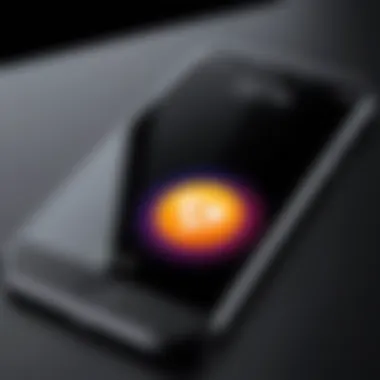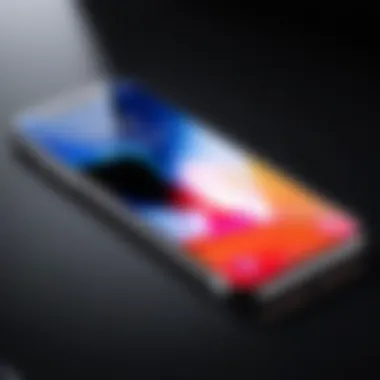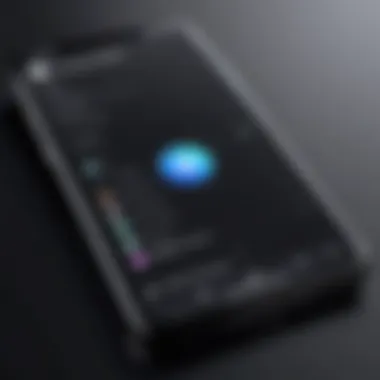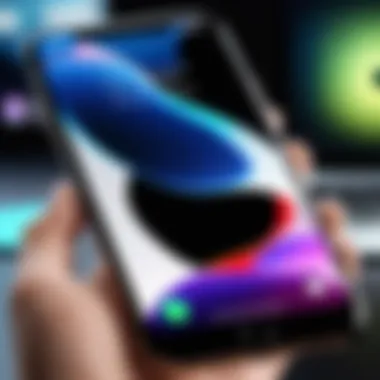Recovering Lost Contacts on iPhone 8: Effective Methods


Product Overview
When it comes to managing contacts on the iPhone 8, it’s essential to understand the significance of these little pieces of information. Contacts are not merely names—each entry is a connection, a bridge to another person. This device, rich in features and boasting a sleek design, often faces challenges that may lead to losing these crucial connections.
The iPhone 8 integrates several core functionalities aimed at safeguarding user data, including contacts. It utilizes an intuitive interface, making it easier for tech-savvy individuals to navigate through various settings and options to recover lost information. Important features that aid in this process include iCloud synchronization, iTunes backups, and the ability to employ third-party recovery solutions. These features, if leveraged strategically, can prove invaluable in pinpointing the root causes of lost contacts and remedying them effectively.
Understanding Contact Loss
Before diving into recovery approaches, it's prudent to understand how contacts may vanish from your device. The loss can stem from:
- Accidental deletion: Erroneous taps can lead to the permanent removal of contacts.
- Software updates: Sometimes, updates can create hiccups resulting in loss of data.
- Syncing issues: Discrepancies in syncing across devices can cause inconsistencies.
Understanding these pitfalls serves as a baseline for better prevention strategies down the line.
Prevention Measures
Taking proactive steps to ensure the integrity of your contacts is vital. Here’s how:
- Regular backups using iCloud or iTunes.
- Ensure that your device is updated to avoid bugs that might compromise data.
- Be cautious when syncing; double-check the selected settings.
"An ounce of prevention is worth a pound of cure."
In the realm of technology, this adage holds especially true as the consequences of data loss can be far-reaching.
Recovery Solutions
Let’s unravel the specific methods for restoring contacts on an iPhone 8. This section will categorize recovery approaches into three main avenues:
- Using iCloud:
- Via iTunes:
- Third-Party Tools:
- Ensure you have an active internet connection.
- Go to Settings > [your name] > iCloud.
- Toggle on Contacts if it’s not already active.
- If contacts were lost due to deletion, check the iCloud.com website as past deletions may be recoverable from there.
- Connect your iPhone to your computer.
- Launch iTunes and select your device.
- Click on "Restore Backup." Choose the most relevant backup that may contain the lost contacts.
- Tools like Dr.Fone or Tenorshare UltData provide another route for users seeking recovery when built-in solutions fall short. These tools usually have user-friendly interfaces but recommend proceeding with caution to avoid data loss in the process.
Each method carries its own nuances and can be adapted based on specific user needs.
Final Thoughts
While losing contacts can feel like a disaster, it’s essential to remember that recovery is often just a few steps away. By understanding both the technology behind iPhone 8’s contact management and leveraging available resources, users can not only regain lost data but also fortify their approach to data management going forward.
By prioritizing prevention and knowing recovery methods, the hassle of lost contacts can be minimized significantly, ensuring seamless communication remains just a tap away.
Prolusion to Contact Loss on iPhone
In today’s fast-paced world, where maintaining connections is crucial, losing contacts on your iPhone 8 can feel like a gut punch. The importance of this topic cannot be overstated, as contacts serve as the digital links to friends, family, and work associates. Without them, reaching out to anyone can turn into a frustrating game of guesswork, which nobody wants to play.
Understanding how contact loss can occur is the first step towards recovery. Various factors—be it accidental deletion, software glitches, or settings mishaps—can lead to a situation where your valuable contact info is simply missing. When this happens, knowing your options for recovery becomes paramount.
Benefits of tackling contact loss effectively cannot be ignored:
- Time-Saving: Quick recovery methods can help you restore contacts without spending hours scouring through files.
- Stress Reduction: By learning the solutions ahead of time, you reduce the panic that comes when you realize your contacts are gone.
- Data Integrity: Knowing how to backup and manage your contacts ensures you won't face these issues down the road.
Understanding the Issue
To appreciate why contact loss happens, one must first recognize that our iPhones are essentially mini-computers. They house not just our contacts, but also a treasure trove of personal and professional life. Given their complexity, issues can arise. Earlier, people ignored data loss, thinking it to be an overly technical concern. But now, it’s as common as the hiccups in a conversation.


Every day, thousands of users on platforms like Reddit share their woe tales over disappearing contacts. Some have experienced this due to syncing issues, while others find their contacts wiped clean after a software update. Diving deep into these stories provides insights into common patterns that can help diagnose the issues more effectively.
Common Scenarios Leading to Contact Loss
When we look at contact loss, a few scenarios keep popping up. Knowing them can ensure you're on guard. Here are some common situations:
- Accidental Deletion: One wrong swipe in your contacts app can wipe out entries in a flash. It’s easy to press the wrong button and before you know it, an important number is gone.
- Software Update Issues: Upgrades don’t always go smoothly. Sometimes, they can lead to contact data not being transferred properly.
- iCloud Settings Misconfiguration: If your iCloud isn't set up right, it can lead to contacts not syncing correctly across devices.
- Device Synchronization Errors: Mismatched settings between devices can cause loss of contact data, especially for those who switch between multiple Apple products.
Each scenario can be disheartening, but understanding them is half of the battle. With a clear grasp of these issues, users can take effective steps to safeguard their contact lists and act quickly when things go wrong.
Potential Causes of Lost Contacts
When it comes to contact loss on your iPhone 8, understanding the underlying causes is crucial. There’re several reasons why one might find themselves in a jam, and identifying these potential pitfalls can save significant time and headaches in recovery efforts. This section delves into these causes with practical insights, shedding light on how they happen, which can help you steer clear from similar situations in the future.
Accidental Deletion
Accidental deletion is, without a doubt, one of the most common culprits behind lost contacts. It can happen in a flash. One moment, you’re scrolling through your contact list, and the next, you accidentally tap on the wrong button. Perhaps, you thought you were selecting a contact to send a message, but instead, you’ve deleted it altogether.
It’s important to note that this mistake might not always finally register in the user's mind until they need that contact. Subsequently, they find themselves in a predicament, scrambling to recall the specifics of how to recover it. Having a solid backup plan is indeed a game-changer.
Software Update Issues
Technological advances often come with their fair share of quirks. During software updates, issues may arise that can lead to lost data, including contacts. For instance, if an update is interrupted — think about losing battery power mid-process — it may cause your phone to misbehave.
In some cases, glitches following an update can reset your settings or even corrupt existing data. So, it’s wise to back up your device regularly. Not only can this safeguard your contacts, but familiarizing yourself with the update process can help you sidestep potential mishaps too.
iCloud Settings Misconfiguration
Many users utilize iCloud for the seamless synchronization of their contacts across devices. However, if your iCloud settings are not dialed in correctly, you may unknowingly disable contact syncing. For instance, if you sneak into settings and toggle important options on or off without fully grasping their implications, you might find your contacts vanishing into thin air.
Checking your iCloud settings regularly ensures that everything is functioning smoothly. If something seems amiss, it’s essential to troubleshoot promptly rather than allowing confusion to linger.
Device Synchronization Errors
Synchronization between devices should be a straightforward process. However, sometimes it can hit a snag. Suppose you’ve got your iPhone 8 connected to multiple devices or applications. If they are not all on the same page, such as differing accounts or incompatible software versions, you could experience contact loss.
One example is if you’ve linked your iPhone with a third-party app that manages your contacts poorly. They might conflict with your phone’s data management system, leading to confusion and loss. Regularly reviewing those connections can help ensure that such hiccups are minimized.
Utilizing iCloud for Contact Recovery
When dealing with lost contacts on your iPhone 8, the option to utilize iCloud can be a true lifesaver. It's not just about being able to restore your contact list; it represents a broad ecosystem designed for data integrity and smooth operation across devices. The real charm of iCloud lies in its seamless integration with Apple's environment, offering a guard against unexpected loss.
Accessing Your iCloud Account
Getting into your iCloud account is the first step toward reclaiming lost contacts. The process is straightforward, but it does require the right credentials. You’ll need your Apple ID and password. Here’s a quick rundown:
- Open your iPhone and head to Settings.
- Tap your name at the top, which takes you to your Apple ID settings.
- From there, you’ll see options including iCloud.
- If prompted, enter your Apple ID and password.
Once in, you can see what data is being stored and choose what to sync to your iPhone. The interface is usually user-friendly, making it easy to navigate even for those not tech-savvy. However, remember, if you're locked out, retrieving your Apple ID will complicate matters, so keep that info handy.
Restoring Contacts through iCloud
Now, restoring contacts is where iCloud truly shines. It's not just a backup, it's more of an on-demand retrieval service!
Steps to Restore from iCloud Backup
Restoring contacts from an iCloud backup can be boiled down into several clear steps:
- Go back to Settings and tap on [your name], then select iCloud.
- Make sure Contacts is toggled on.
- If your contacts aren’t appearing, this could mean they were lost after the last sync, so you may need to perform a deeper dive into your backups.


The noteworthy feature here is that once you activate the sync option, your iPhone starts pulling the latest data from iCloud, making it a favored choice for many users to get their contact list back without needing extensive know-how. Still, keep in mind that restoring involves replacing the current list, so be sure you want to overwrite any new additions made since backup.
Checking for Recent Changes
This part of the recovery process is crucial. If you realize that recent changes—either accidental deletions or new entries—need addressing, it’s essential to check your iCloud settings:
- Open the Contacts app on your iPhone.
- Scroll to the bottom of the list to see if all recent entries are visible.
This feature is advantageous because it allows users to monitor what’s new or missing. It's like looking into a snapshot of your history. Should you discover a gap, going back to that iCloud backup could help retrieve those lost connections. However, if you keep updating your iPhone regularly, you may find that the most recent changes aren't yet reflected in the iCloud, necessitating some patience.
Synchronizing Contacts to iPhone
Once your contacts are safely restored from iCloud, you'll want to ensure they stay synchronized. This means enabling continuous syncing with iCloud:
- Go to Settings > [your name] > iCloud.
- Make sure Contacts is switched on.
This ensures that every time you add or modify a contact, it’s automatically updated in iCloud. It’s a clear-cut way to breathe easier, knowing all contact information is backed up to the cloud and ready for retrieval whenever needed. Keeping an eye on these settings can really help in minimizing future woes related to lost contacts.
Using iTunes for Data Restoration
When it comes to retrieving lost contacts on your iPhone 8, one method that often stands out is using iTunes for data restoration. This approach is particularly important because it enables users to recover information stored locally on their devices or within backups. Most users might not realize that iTunes keeps copies of their data, which can be a lifesaver when things go awry. Restoring from an iTunes backup can be more straightforward than navigating through various cloud solutions especially for people comfortable with desktop applications.
Connecting Your iPhone to iTunes
Connecting your iPhone to iTunes is a simple task but one that can set the stage for an effective restoration process. To start, you need to ensure you have the latest version of iTunes installed on your computer. Launch iTunes and use your charging cable to connect the iPhone to your computer. Once connected, your device should appear in the top left corner of the iTunes window. This indicates that iTunes recognizes your iPhone, paving the way for the next steps. If prompted, trust the computer on your iPhone before proceeding to the backup management.
Restoring from an iTunes Backup
Restoring your lost contacts from an iTunes backup involves a few methodical steps.
Choosing the Appropriate Backup
Selecting the right backup is vital in ensuring that you fetch the correct data. iTunes often creates multiple backups especially if you make regular syncs; hence, it can sometimes feel like finding a needle in a haystack. One key characteristic of choosing the appropriate backup is recognizing the date and time when each backup was created. Picking a backup that aligns with the period before you lost your contacts is essential. This choice greatly benefits your restoration process as it can prevent overwriting important data saved after your contacts went missing. Additionally, using the 'Preferences' option in iTunes can help you locate old backups more efficiently, making your search a bit less cumbersome.
Implications of Restoration
Understanding the implications of restoration is equally crucial. Restoring from an iTunes backup means that your device will revert to the state it was in at the time of that backup. This means any recent data—like new notes, messages, or contacts—can be wiped out. This key characteristic of iTunes restoration can be both beneficial and risky. You gain access to lost contacts, but you also risk losing any new information created after that backup was made. Therefore, assessing what you have added recently is vital before you dive into restoring. Users must weigh the advantages of recovering old data against the potential headache of data loss. Pro tip: Always create a new backup of your current device state before initiating a restoration. This way, you can mitigate the risk of losing critical recent information altogether.
Exploring Third-Party Recovery Tools
In the landscape of recovering lost contacts on the iPhone 8, the discussion is incomplete without the mention of third-party recovery tools. These tools can play a crucial role, especially when the built-in options don’t yield desired results. They provide a lifeline for those who may find themselves scrambling to restore important contacts that seem to have vanished.
Why consider third-party software? Well, sometimes, the native methods may be limited, or the situation might fall outside the usual parameters—like when recovery files become corrupt or when a user has not performed regular backups. Third-party options can offer deeper layers of scanning and recovery that go beyond the typical realms of iTunes and iCloud, diving into areas that other solutions simply can't.
"Sometimes, you need to go the extra mile when it comes to data recovery."
However, choosing to go the third-party route is worth pondering over. There are a few aspects every user should evaluate:
- Reliability: Not all software are created equally. It’s vital to research and confirm that the tool has good reviews, particularly from users with similar experiences. Verification from platforms like Reddit or discussion boards can reveal common issues or unexpected success stories.
- User Interface: A tool with a steep learning curve may not be worth the time. After all, when you’re under pressure to recover contacts, the last thing you need is to wrestle with complex software.
- Compatibility: Ensure the recovery software is compatible not just with the iPhone 8 but also with the iOS version currently running on the device. Check the specific details; some may not work with the latest updates.
At its core, adopting the use of third-party recovery tools is fundamentally about enhancing the likelihood of restoring lost contacts, especially when the stakes are high. This sets the stage for examining specific options that have carved out a notable place in the industry.
Evaluating Industry Options
When it comes to third-party recovery tools, several options stand out. Each tool offers various features and advantages that can address different recovery situations. Before diving into specific software, it's useful to consider the common features these tools provide:
- Deep Scanning: Many recovery tools offer advanced scanning options that can dig deep into your device, far beyond standard restoration capabilities.
- Preview Functionality: Some tools allow users to preview recoverable contacts before proceeding with the restoration, giving a sense of control over the recovery process.
- Multiple Format Support: Depending on your needs, you may prefer tools that can recover not just contacts but also other forms of data like messages or photos.


In the vast sea of available software, identifying and selecting a reputable choice could save users a headache down the line.
Recommended Recovery Software
Several recovery tools have gained traction among users for their effectiveness in restoring lost contacts. Here’s a glimpse into some of the most recommended solutions:
- Dr.Fone - Data Recovery (iOS): Known for its user-friendly interface, Dr.Fone specializes in recovering various types of data from iPhones. With a high success rate, it’s a go-to for many in similar situations.
- Tenorshare UltData: This tool shines with its ability to recover lost contacts without a backup. Its features include selective recovery, which means you can restore only the contacts you need rather than everything.
- iMobie PhoneRescue: Particularly useful for its versatility, PhoneRescue caters to various iOS data recovery needs. It’s touted for its deep scan capabilities, which are crucial when contacts are hard to retrieve.
- EaseUS MobiSaver: Not only does it handle contact recovery well, but it also does so with data integrity in mind, making it a reliable option for users focused on maintaining data quality during recovery.
When venturing into the third-party realm, keep in mind the importance of trial versions. Trying before buying often leads to better satisfaction and helps ascertain if the tool genuinely meets your needs.
As much as these tools can serve as handy solutions, they require a careful hand in selection and usage. Opting for a trusted recovery software can be the deciding factor in successfully retrieving those elusive contacts.
Preventive Measures Against Future Contact Loss
In the digital age, losing contacts can feel like misplacing pieces of your identity. That's why focusing on preventive measures is essential when it comes to safeguarding your contacts on the iPhone 8. This section is about more than just recovery; it’s about making sure you don't find yourself in a tight spot again. From understanding the frequency of backups to configuring settings correctly, these precautions not only help maintain your data but also give you peace of mind.
Regular Backups: Importance and Frequency
One of the cornerstones of contact preservation is regular backups. Think of backups as your safety net—when you fall, you want something to catch you. By routinely backing up your data, you'll avoid the headache of sudden losses. iCloud offers simple options for automatic backups, making it easier to set and forget. However, it’s also wise to perform manual backups through iTunes or other platforms as an extra layer of protection.
Here’s how frequently to back up:
- Daily: If you have lots of changes or add contacts frequently.
- Weekly: For general users who add a moderate amount of data.
- Monthly: If your contact list remains static.
Tip: Set a reminder on your calendar to check your backup settings regularly to avoid surprise heartaches in the future.
Maintaining Proper iCloud Settings
Proper configuration of iCloud settings plays an instrumental role in ensuring your contacts stay safe. Many users overlook this, and then wonder why their contacts seem to vanish in the blink of an eye. Here’s a couple of key considerations for iCloud:
- Check Your iCloud Sync Options: Make sure the Contacts toggle is turned on.
- Verify Your Account: Sometimes, error messages may appear if the system isn’t recognizing your login details.
Also, make sure to check your storage space. If your iCloud is full, new changes might not sync properly, leading to data loss. It’s a simple step but often falls by the wayside.
Limitations of Manual Deletion
While managing your contacts manually may seem straightforward, caution is necessary. Many people delete contacts without realizing the implications. Accidental deletions happen more often than you might think—especially when you are in a rush or making changes on-the-go.
Here are some limitations to keep in mind regarding manual deletion:
- Accidental Selection: It’s easy to select the wrong contact, especially with a large list.
- No Recycle Bin: Once you hit delete, that information is often gone for good unless backed up.
To minimize the risk, double-check before confirming deletions and consider using a confirmation prompt when removing contacts. Playing it safe can save you a lot of trouble later.
"An ounce of prevention is worth a pound of cure."
Culmination
In the final analysis, understanding how to restore lost contacts on the iPhone 8 isn't just a trivial task; it's crucial for maintaining communication in an increasingly connected world. Those who find themselves in such predicaments often face not only the hassle of re-establishing connections but also the emotional toll of misplaced memories and important contacts. The various approaches discussed throughout this article offer promising strategies for retrieval.
Summarizing Recovery Strategies
To summarize, several effective methods exist for recovering lost contacts:
- Utilizing iCloud: Sign into your iCloud account and restore contacts from an automatic backup. This is generally the easiest solution, leveraging the cloud's potential to preserve your data securely.
- Using iTunes: You can connect your iPhone to iTunes and restore from a previously saved backup. This method requires that you have made backup copies in the past, so it’s advisable to do so regularly.
- Exploring Third-party Tools: There are numerous third-party applications available that claim to retrieve lost contacts. It's essential to evaluate these tools carefully, considering user reviews and success rates.
In all cases, the key lies in a proactive approach to data management, regularly updating backups, and ensuring cloud settings align with data protection goals.
Future Outlook on Contact Management
Looking ahead, the landscape of contact management for devices like the iPhone 8 will likely continue to evolve. With the increasing integration of artificial intelligence and cloud technologies, there will be enhanced capabilities for automatic backups and real-time sync features.
For tech-savvy individuals, keeping up with these technological advancements is essential. They can ensure that not only are their data safety concerns addressed, but also harness new tools that make managing contacts easier. Moreover, the emphasis on privacy and data protection will demand more user education.
"An ounce of prevention is worth a pound of cure." This old saying rings true, especially in the context of contact management. Regular backups and timely updates will help users mitigate future issues. The importance of making sure all settings align correctly can’t be overstated.



